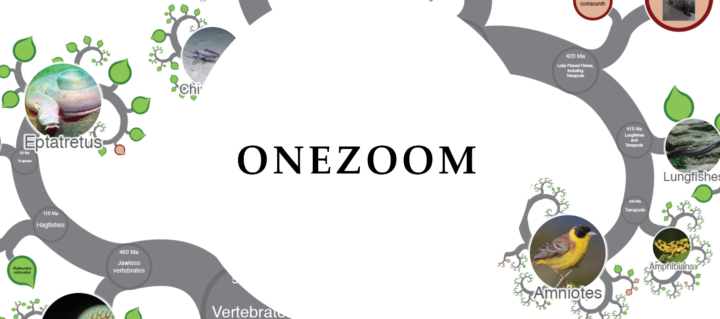OneZoom: Tree of Life explorer

OneZoom is a freely available Tree of Life, connecting all species together in a spiraling beanstalk that shows evolutionary history.
Each leaf on the OneZoom tree represents a species and the branches show how they are connected through evolution. Discover your favourites, see which species are under threat, and wonder at 105,307 images on a single page. It is a great way of visualising all life on Earth.
Our guide hopes to give you some examples of ways that you can explore OneZoom to gain new information about planet Earth’s vast Tree of Life.
Visit www.onezoom.org/linnean to explore OneZoom.
Suggested activity 1: Without using the search-bar, find Homo sapiens.
Keep zooming inwards, following the Animal line and asking if we are more closely related to one side of the tree or the other.
For example, when you get to Nephrozoa, one side shows a bird and the other shows a ladybird - which do you think we’re more closely related to?
Suggested activity 2: Find out when there was a common ancestor of lions and bears
Lions and bears are different creatures, obviously, and they look very different. However, they both have four feet (quadrupeds), eat meat (carnivorous) and give birth to live young (mammals).
Use the common ancestor tool to find out when their common ancestor lived. You can click on circles and leaves which provides more information from different sources like Wikipedia.
In this case, the common ancestor might have looked something like this.
Trees of Life – A Visual History

The idea of a tree as a metaphor for understanding and graphically displaying relationships among organisms is most often attributed to Charles Darwin (1809–1882), who fully developed the notion in his 1859 Origins of species by means of natural selection. However the concept is considerably older, and can be traced back to the Greek philosophers Aristotle and Plato, and the Great Chain of Being, which was developed throughout the Middle Ages and well into the 18th century.

As part of the launch of a new explorer for the complete tree of life produced by the UK charity OneZoom, a display in the Library of the Linnean Society explores the visual history and wide variety of forms of trees of life. The display starts from Carl Linnaeus (1707–1778) and his use of dichotomous diagrams, which were the ubiquitous amongst 18th century naturalists. It then explores other forms of displaying relationships between organisms: Charles Bonnet's (1720–1793) staircase Great Chain of Being, or Scala naturae (ladder of nature), which portrays the temporal order in which God created life on Earth, with man at the top; George Louis Leclec de Buffon's (1707–1788) genealogical diagram of the races of dogs; and early evolutionary trees such as Nicolas Charles Seringe's (1776–1858) dichotomous branching tree representing the species of the willows of Switzerland (genus Salix) or Antoine-Nicolas Duchesne's (1747–1827) upside-down tree of nine races or varieties of strawberries.

The first concept of a tree of life as a diagram that shows the evolutionary divergence or branching of groups of organisms through time was first drawn by Jean-Baptiste Lamarck (1744–1829) in 1809, fifty years before Darwin’s famous branching diagram. The end of the 19th century and early 20th century signalled the end of all other ways of displaying relationships between organisms in favour of the tree of life. Some biologists were great tree makers, such as Ernst Haeckel (1834–1919), who drew hundreds of visually striking genealogical trees to which specific biological taxa were assigned.
Over the last century, the discovery of genetics and molecular biology have made the tree of life one of the most important organizing principles in biology. Attempts have been made to design a universal tree of life, most notably by David Mark Hillis (1958–), in the form of a radial branching diagram. But even an approximation of the full scale of the tree has remained elusive.
Reference
PIETSCH, Theodore W. Trees of Life : A Visual History of Evolution. Baltimore, Md.: Johns Hopkins University Press, 2012.
